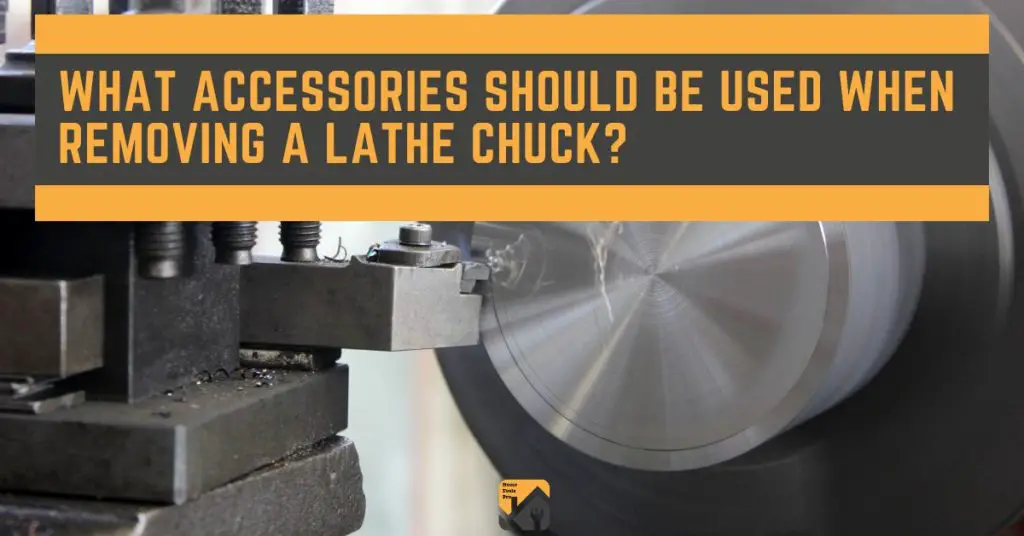A lathe chuck is a type of clamp used to hold an object in place while it is being rotated by a lathe. Chucks are also used on other types of machines, such as wood routers and milling machines.
What should be used when Removing a Lathe Chuck?
There are a few accessories that should be used when removing a lathe chuck. Which are,
- Chuck Key
- Strap Wrench
iii. Rubber Hammer
- Sturdy Piece of Wood
As well as, there are tools that should not be used as those could be harmful to Chuck or Lathe. Which are,
- Metal Hammer
- Any other Heavy Tools used to Hit
In this article, we will look further at Lathe Chucks in different aspects, including how to use, care and work with them.
Also, the different types of lathe chuck are used for different machines, and overall safety measures should be followed when working with lathe chucks.
How to Remove a Lathe Chuck?
There are several ways to remove a lathe chuck from a machine. The most common way is to use a wrench or other similar tool to loosen the retaining bolts that hold the chuck in place.
Another method is to use an air-powered impact wrench. This method is typically used when the chuck is very tight and difficult to remove with a hand tool.
Once the retaining bolts have been loosened, the lathe chuck can be removed by hand. If the chuck is still tight, it may need to be tapped with a rubber hammer to loosen it.
At the risk of falling the chuck due to its heavy weight, you can use a strap wrench to run around and hold it tight or use the sturdy piece of wood to lockup up in the treads of the chuck and grab it firmly.
Once the chuck has been removed, it can be cleaned and inspected for damage. Damaged chucks should be replaced with new ones.
Lathe chucks are an important part of the lathe and should be handled with care. Always follow the manufacturer’s instructions when installing or removing a lathe chuck.
Visual Explanations:
Can Chuck or Lathe Spindle get Damaged when Installing & Removing a Lathe Chuck?
It is important to handle a lathe chuck with care, whether you are installing it or removing it from the lathe. Improper installation or removal can damage the chuck or the lathe spindle, which can cause serious problems when using the lathe.
When installing the chuck, be sure to thread it onto the spindle by hand until it is snug. Using a wrench to tighten it further can damage the threads.
Once the chuck is tight, use a piece of wood or your hand to tap it into place. Do not use a hammer, as this can also damage the chuck or spindle.
To remove the chuck, first, loosen it by hand. If it is very tight, you may need to use a wrench, but be careful not to damage the threads.
Once it is loosened, you can remove it by hand. Again, avoid using a hammer or other tool to remove the chuck, as this can damage it or the spindle.
Suppose you are unsure about properly installing or removing a lathe chuck, consult a professional. Trying to do it yourself could result in serious damage to your lathe.
How can a Lathe Chuck get Stuck in the Lathe Spindle?
A lathe chuck can become stuck in the lathe spindle for a variety of reasons. The most common reason is due to wear and tear on the chuck itself.
Over time, the chuck can become slightly misshapen, which can cause it to become stuck in the spindle.
Another common reason for a chuck becoming stuck is if it is not properly secured in the spindle. If the chuck is not tightened correctly, it can become loose and fall out of the spindle, becoming stuck in the process.
If your lathe chuck becomes stuck in the spindle, there are a few things you can do to try and remove it.
First, gently tap on the chuck with a soft rubber hammer. This may help to loosen it. Finally, if all else fails, you may need to disassemble the lathe in order to remove the chuck.
If you find yourself in a situation where your lathe chuck is stuck in the spindle, don’t panic.
There are a few things you can try to remove. With a little patience and some elbow grease, you should be able to get your chuck unstuck and back to work in no time.
How to Install a Lathe Chuck?
There are several different ways to install a lathe chuck onto your lathe.
Once you have determined the size of the chuck that you need, you will need to locate the centre point of the spindle nose on your lathe.
This can be done by measuring from the tip of the spindle nose to the bed of the lathe. Once you have located the centre point, you will need to mark it with a pencil or pen.
Next, you will need to prepare the chuck for installation. This involves cleaning the spindle nose and the chuck threads with a clean cloth.
Once they are both clean, you will need to apply a thin layer of oil to the spindle nose and the chuck threads. This will help to prevent rust and corrosion.
Now, you are ready to install the chuck. To do this, you will need to align the centre point that you marked on the spindle nose with the centre point of the chuck.
Once they are aligned, you will need to start screwing the chuck onto the spindle nose. You will need to use a wrench to tighten it completely.
Finally, you will need to test the chuck to make sure that it is installed correctly.
To do this, you will need to set the lathe to a slow speed and then try to mount a piece of wood onto the chuck. If the chuck is installed correctly, it should grip onto the wood securely.
Visual Explanations
How to use a Lathe Chuck?
Several different types of lathe chucks are available on the market, each designed for specific purposes.
The most common type of chuck is the three-jaw chuck, which is ideal for gripping round stock. Other types of chucks include four-jaw chucks, collet chucks, and magnetic chucks.
To use a lathe chuck, first ensure that it is properly mounted on the lathe spindle.
Next, select the appropriate size and type of jaws for the stock being machined. For example, if you are machining a piece of round stock, you will need to use a three-jaw chuck.
Once the jaws are in place, tighten them down onto the stock using the chuck key. Be sure not to overtighten the jaws, as this can damage the stock or cause it to slip out of the chuck during machining.
With the chuck tightened down onto the stock, you are now ready to begin machining.
When finished, loosen the chuck jaws and remove the stock from the chuck. Be sure to unload any tools that were being used before removing the stock, as leaving them in place can damage the chuck.
Types of Lathe Chucks
– 3 Jaw Chuck:
A 3 jaw chuck is a type of chuck that is used to grip an object in a lathe. It consists of three jaws that open and close around the object. The three jaws can be moved independently of each other, which allows for a variety of different shapes and sizes to be gripped.
– 4 Jaw independent Chuck:
A 4 jaw independent chuck is a type of lathe chuck with four jaws that can move independently. This allows for greater flexibility when clamping different shapes and sizes of workpieces. 4 independent jaw chucks are typically used for more complex machining operations where greater precision is required.
– Combination Chuck:
A combination chuck is a type of lathe chuck that is able to grip a workpiece in more than one way. The most common type of combination chuck has three jaws: two outer jaws that move in and out and one central jaw that moves up and down. This allows the chuck to grip round, square, or hexagonal-shaped workpieces.
– Magnetic Chuck:
A magnetic chuck is a type of work holding device that is used on a lathe to hold ferromagnetic workpieces.
The chuck consists of a permanent magnet that creates a magnetic field and a steel plate that is attracted to the magnet. The workpiece is clamped to the plate and held in place by the magnetic force.
– Collet Chuck:
A collet chuck is a type of chuck that uses a collet to grip the workpiece. Collets are tapered sleeves with internal serrations that match those on the outside of the chuck body.
Visual Explanations:
Safety Tips to follow when Using a Lathe Chuck
When using a lathe chuck, always take safety precautions to prevent injuries. Here are some tips to follow:
- Read the lathe chuck’s manual before use. Familiarize yourself with the tool and how it works.
- Wear proper safety gear when operating the lathe chuck. This includes eye protection, gloves, and hearing protection.
- Inspect the lathe chuck and workpiece for any damage before beginning work. Do not use the lathe chuck if it is damaged in any way.
- Mount the workpiece securely in the lathe chuck before starting the lathe. Make sure that the workpiece is not loose and that all moving parts are free of obstruction.
- Store the lathe chuck in a safe place when not in use. Cover it with a dust cover to keep it clean and protected.
You can prevent accidents and injuries by following these safety tips when using a lathe chuck. Always use the lathe chuck with caution and handle it with care to avoid any accidents.
Related Matters
-
How do you open a seized chuck?
There are a few ways to do this. One is to use a vice grip to try and get a good grip on the chuck and then loosen it using a wrench.
Another option is to try and use a rubber hammer and chisel to get between the chuck and the shaft, then twist the chuck off.
Finally, you can also try heating up the chuck with a torch in order to expand the metal and make it easier to remove.
-
What should you use to remove a chuck that screws on a lathe spindle?
The best way to remove a chuck that screws onto a lathe spindle is to use a lathe chuck removal tool.
A lathe chuck removal tool is a special tool that you can use to remove a chuck from a spindle. It has two metal arms that grip the chuck and pull it off the spindle.
If you don’t have a lathe chuck removal tool, you can try using pliers or an adjustable wrench to remove the chuck. However, these tools may damage the chuck or the spindle.
-
How do you remove a threaded chuck?
There are a few ways that you can remove a threaded chuck. One way is to use a spanner or wrench to turn the chuck counterclockwise. Another way is to use a socket wrench to turn the chuck counterclockwise.
Another way is to use a drill bit to drill into the chuck and then use a screwdriver or Allen key to turn the chuck counterclockwise. Another way is to use a hammer and chisel to chip away at the chuck until it falls off.



